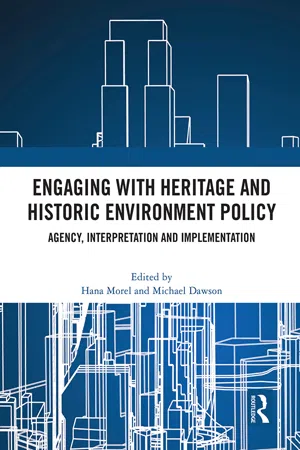
Engaging with Heritage and Historic Environment Policy
Agency, Interpretation and Implementation
- 234 pages
- English
- ePUB (mobile friendly)
- Available on iOS & Android
Engaging with Heritage and Historic Environment Policy
Agency, Interpretation and Implementation
About This Book
A comprehensive review of policy and practice in the historic environment, this book exposes the tensions, challenges and difficulties faced by the heritage sector at a time of political volatility.
This collection comes at a key moment for planning policy in the historic environment of England. The papers reflect a wide range of views and experience in the practical environment of policy and implementation. Contributors give perspectives on both policy and practice from legal counsel to local authorities, from the country's largest NGO to the museums sector. Some conclusions are controversial, providing an important insight into the operation of national and local government.
The thrust of the volume is the need to close the gap between research and policy production. Written when the UK government's White Paper, Planning for the Future (August 2020), was in preparation, the chapters explore the implementation of policy, its unexpected and unanticipated outcomes and the enduring legacies of guidance and established practice. It highlights tensions within the sector and the need for collaboration and partnership. This book is the most recent and comprehensive review of how the heritage sector has evolved and draws special attention to the importance of the historic environment, not just in planning policy but for the country as a whole.
The chapters in this book were originally published in The Historic Environment: Policy & Practice.
Frequently asked questions
Information
Power of Place - Heritage Policy at the Start of the New Millennium
The resulting document, Power of Place – the future of the historic environment, anticipated many issues that have subsequently become mainstream elements of policy and practice including conservation-led regeneration, tackling heritage at risk, reviewing public parks and publishing regular state of the historic environment reports. Other recommendations still remain challenging in policy terms – including encouraging better maintenance, promoting craft skills, putting heritage at the heart of education, understanding what people value and why, enabling more participation, managing change, making the regulatory system work better and supporting local leaders.
This article simply sets out to raise awareness of that initiative, as a contribution to the history of heritage policyin England.
Introduction
Protecting Our Heritage
Power of Place
Table of contents
- Cover
- Half Title
- Title Page
- Copyright Page
- Contents
- Citation Information
- Notes on Contributors
- Introduction: Engaging with Policy in England - Agency, Interpretation and Implementation
- 1 Power of Place - Heritage Policy at the Start of the New Millennium
- 2 Principles into Policy: Assessing the Impact of Conservation Principles in Local Planning Policy
- 3 The Disconnect between Heritage Law and Policy: How Did We Get Here and Where are We Going?
- 4 Heritage Assets: Decision Making in the Real World
- 5 It’s Not Mitigation! Policy and Practice in Development-Led Archaeology in England
- 6 Borderlands: Rethinking Archaeological Research Frameworks
- 7 Archaeology, Conservation and Enhancement: The Role of Viability in the UK Planning System
- 8 For Everyone?: Finding a Clearer Role for Heritage in Public Policy-making
- 9 Always on the Receiving End? Reflections on Archaeology, Museums and Policy
- 10 Historic Environment Policy: The View from a Planning Department
- 11 The Heritage-creation Process and Attempts to Protect Buildings of the Recent Past: The Case of Birmingham Central Library
- 12 Pathways to Engagement: The Natural and Historic Environment in England
- Index